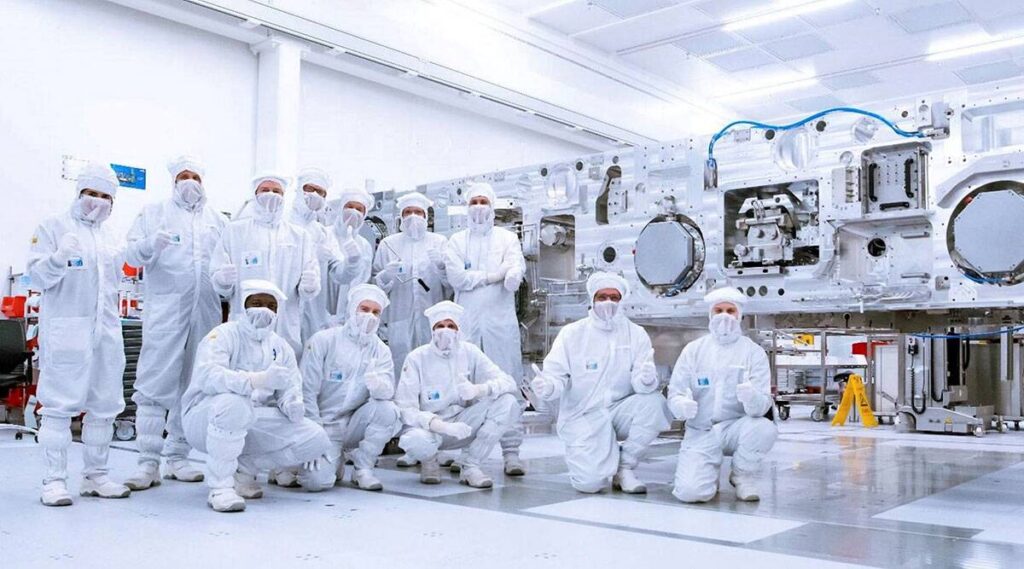ASML has enjoyed a rosy decade, its shares leaping 1,000% to take its value past 200 billion euros as it swept up most of the world’s business for these lithography systems.
ASML, a semiconductor industry and stock market giant, has to think smaller. Or maybe bigger. It is building machines the size of double-decker buses, weighing over 200 tonnes, in its quest to produce beams of focused light that create the microscopic circuitry on computer chips used in everything from phones and laptops to cars and AI.
The company has enjoyed a rosy decade, its shares leaping 1,000% to take its value past 200 billion euros as it swept up most of the world’s business for these lithography systems.
It’s now preparing to roll out a new $400 million machine for next-generation chips which it hopes will be its flagship by the late 2020s but for now remains an engineering challenge.
Executives at ASML’s headquarters in the Dutch town of Veldhoven told Reuters a prototype was on track to be completed in the first half of 2023. They said the company and longtime R&D partner IMEC were setting up a test lab on the spot – a first – so top chipmakers and their suppliers can explore the machine’s properties and prepare to use production models as early as 2025.
Yet, as investors expect further dominance and growth to justify ASML’s valuation at 35 times 2021 earnings, there is little margin for error should the company encounter technical or supply-chain snags.
“Every check is green right now,” said Christophe Fouquet, head of EUV programs at ASML. “But, you know, we still have to see it all (assembled) together.”
EUV stands for extreme ultraviolet, the wavelength of light used by ASML’s most advanced machines.
The fortunes of the project are also important for ASML’s customers, chipmakers racing to expand production amid a global shortage. They include U.S. player Intel, South Korea’s Samsung and Taiwan’s TSMC, the biggest, which makes chips for the likes of Apple, AMD and Nvidia.
Industry specialist Dan Hutcheson of VLSI Research, who is not involved with the ASML project, said the new technology – known as a “High-NA” version of EUV – could provide a significant advantage to some chipmakers.
“It’s a bit like who’s got the best gun,” he said. “So either ASML makes it happen or they don’t make it happen,” he added. “But if they make it happen, and you don’t have your orders and you miss out on this, you’ve immediately made yourself non-competitive.”
He said TSMC eclipsed its rivals by integrating ASML’s EUV machines first in the late 2010s – a mistake Intel CEO Pat Gelsinger has vowed not to make again with High-NA.
Lithography is a key determinant of how small circuitry on a chip can get, with High-NA promising a 66% reduction. Smaller is better in chipmaking, as the more transistors you pack in the same space, the faster and more energy efficient a chip can be.
Circuitry is now approaching the atomic level, leading to predictions that the end is nigh for “Moore’s Law”, a famous 1960’s observation that the number of transistors on a microchip doubles about every two years.
“If they (ASML) don’t succeed it will become difficult to continue with Moore’s Law,” said Jos Versteeg, an analyst at Dutch-based bank InsingerGilissen, though he noted engineers had defied similar doubts in the past.
First light on silicon
Since 2000, ASML has rapidly taken market share from Japanese competitors Nikon and Canon, which now mainly focus on older technology. ASML controls more than 90% of the lithography market. No competitor is attempting to build an EUV system, citing high development costs.
Shortages of ASML’s machines, which cost up to $160 million each, are a bottleneck for chipmakers, who have plans to spend more than $100 billion in the coming years to build extra fabrication plants to meet demand.
The High-NA machines will be about 30% bigger than their predecessors, which themselves require three Boeing 747s to carry them in sections.
IMEC, a non-profit research group that cooperates with companies across the semiconductor industry, believes setting up the lab at ASML could save up to a year in development time.
ASML said it had five orders for pilot machines, which should be delivered in 2024, and “more than five” orders from five different customers for faster production models for delivery starting in 2025.nBut this is no slam-dunk.
There are formidable challenges in integrating a host of complex components, including an optics system of polished, hyper-smooth curved mirrors, which are being built in a vacuum by Germany’s Carl Zeiss.
Versteeg at InsingerGilissen said that while ASML enjoyed a near monopoly, its “pricing is dependent on the productivity of the machines”. Meanwhile, it must sell EUV tools to the shrinking number of companies that make leading-edge chips, which include memory chip makers SK Hynix and Micron.
ASML is also tied to the wider fortunes of the cyclical chip industry, which some researchers expect to double past $1 trillion in annual sales this decade.
Fouquet worries most about supply-chain issues. “Right now, and like with every other product, we see some stress in the supply chain, and this is if you ask me today, probably the biggest challenge we have with High-NA.”

Source: indianexpress.com

